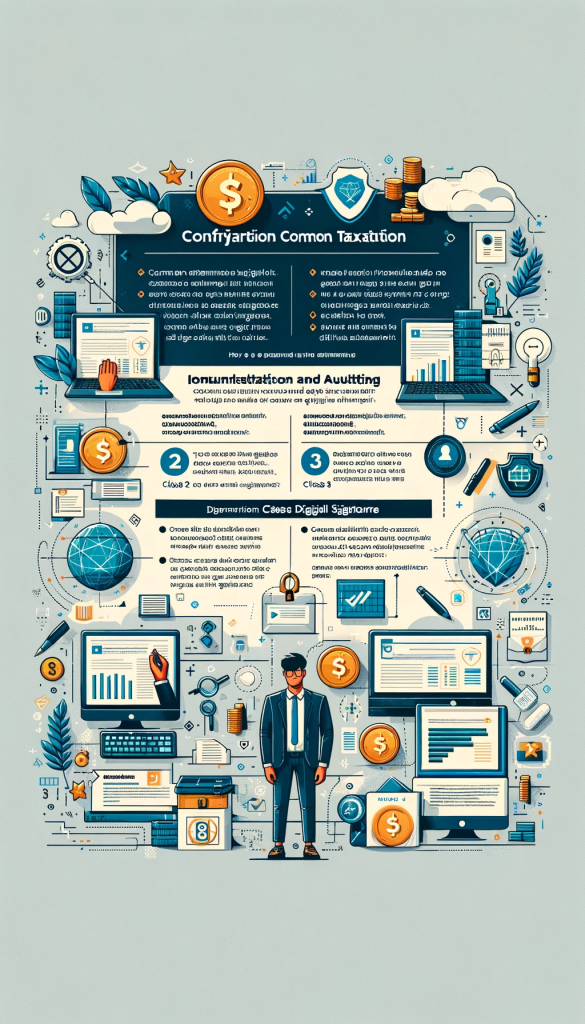Addressing Common Misconceptions about Taxation and Auditing
Taxation and auditing, crucial aspects of financial management, are often clouded by misconceptions. This comprehensive guide focuses on dispelling myths, especially around Class 2 and Class 3 Digital Signatures, crucial in online transactions.
Table of Contents
- Digital Signatures: An Overview
- Class 2 Digital Signature Online
- Class 3 Digital Signature Online
- Common Misconceptions
- Impact on Taxation
- Role in Auditing
- Choosing the Right Class
- Frequently Asked Questions
Digital Signatures: An Overview
Digital Signatures have transformed the landscape of digital transactions, providing a secure and efficient means of authenticating identity and documents. Governed by the Information Technology Act, 2000 in India, they are legally recognized and have become integral in various sectors, including finance, legal, and government services. These signatures use cryptographic methods to ensure the signer’s identity and the document’s integrity, offering a higher security level than traditional signatures.
Class 2 Digital Signature Online
Class 2 Digital Signatures are widely utilized for routine online transactions. Their primary use includes e-filing of tax documents, GST submissions, and corporate filings. They verify the signer’s identity against pre-verified databases, making them ideal for transactions where moderate security is sufficient. Despite some misconceptions, Class 2 Digital Signatures provide reliable security for their intended use, ensuring that data tampering is easily detectable.
Class 3 Digital Signature Online
Class 3 Digital Signatures represent the highest security level in digital signatures. Required for e-tendering, e-auctions, and high-stakes transactions, they necessitate the physical presence of the individual for identity verification. This class is often viewed as cumbersome due to the stringent verification process, but this is a vital step to ensure unmatched security and authenticity in transactions where the stakes are high.
Common Misconceptions
One common misconception about digital signatures is their perceived security level. Many believe they are prone to forgery and hacking; however, they employ advanced cryptographic techniques, making them highly secure. Another myth is that digital signatures are not legally binding. Contrary to this belief, digital signatures hold the same legal status as traditional signatures in many jurisdictions. Also, there is a misconception regarding their implementation and user-friendliness. Modern digital signature solutions are quite intuitive and easily integrate into existing workflows.
Impact on Taxation
Digital signatures have revolutionized the taxation process, making it more streamlined, accurate, and efficient. Class 2 Digital Signatures, in particular, have simplified the filing of income tax, GST, and other related documents. This has led to faster processing, reduced errors, and a decrease in paperwork. The misconception that digital signatures complicate the tax process is unfounded; they have, in fact, simplified and accelerated the procedures, making compliance easier for taxpayers and businesses.
Role in Auditing
In the auditing sector, digital signatures have enhanced the efficiency and reliability of audit processes. They enable auditors to authenticate documents swiftly and securely, facilitating a more streamlined audit process. This shift towards digitalization aligns with global trends towards sustainability, reducing the reliance on paper. Class 3 Digital Signatures are especially crucial in high-security audits, where authenticity and data integrity are paramount.
Choosing the Right Class
Understanding which class of digital signature to use is crucial for ensuring the appropriate level of security and compliance. For general tax filings and corporate transactions, Class 2 Digital Signatures are typically sufficient. However, for activities requiring higher security, such as e-tendering or intellectual property filings, Class 3 Digital Signatures are necessary. The choice depends on the nature of the transaction and the level of security required.
Frequently Asked Questions
- How frequently do digital signatures need to be renewed?
They generally have a validity of one to three years and must be renewed upon expiry to continue their use. - Are digital signatures compatible across various platforms?
Yes, most digital signatures are designed to be compatible with different digital platforms and applications. - Do other countries recognize digital signatures?
Many countries globally recognize and accept digital signatures, though specific acceptance policies can vary. - When is a Class 3 Digital Signature necessary?
It’s essential for high-security transactions like e-tendering. For regular transactions, a Class 2 Digital Signature is usually adequate.
By addressing these common misconceptions, individuals and businesses can better understand and leverage digital signatures in taxation and auditing. This knowledge is key to navigating the digital landscape securely and effectively.

